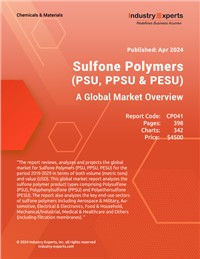Mega trends that will continue to drive sulfone polymer consumption include, but are not limited to, a sustained and increased penetration of sulfone polymers in aircraft and automobiles, supported by ongoing efforts in reducing weight to improve fuel efficiency and meet CO2 emission standards. Additionally, the rising demand for food and consumer items requiring higher temperature limits, as well as the continued utilization of sulfone polymers in membrane applications, contribute to sustained growth. Moreover, insights from industry sources suggest that the ongoing trend of electronics miniaturization, which necessitates materials with elevated temperature requirements, further reinforces the demand for sulfone polymers.
Over the forecast period, as general economic conditions are expected to improve across major consuming regions, global market for sulfone polymers is anticipated to post a CAGR of 5.3% in volume and 6.2% in value terms between 2023 and 2029; and reach 92 thousand metric tons valued at US$1.9 billion by 2029. Future growth of sulfone polymers market is mainly driven by above-average growth in automotive, aerospace & military, and filtration membranes applications coupled with increasing demand in electrical & electronics and medical & healthcare applications.
Research Findings & Coverage
- Sulfone Polymers global market is analyzed in this report with respect to product types and end-use sectors across all major geographic regions and key countries
- Market share analysis covered for Sulfone Polymers based on the segmentation mentioned above and current market size estimation, revenue projections for the analysis period through 2029
- The report includes an in-depth analysis of the market for each end-use sectors along with pandemic influence, recent wars, market constraints and growth drivers
- The production capacity analysis covered for each plastic type by region/country and major players; current capacities analyzed and short term expansions plans illustrated for all major plastic types by country, producer and by plant
- Key business trends focusing on product innovations/developments, capacity expansions, M&As, JVs and other recent industry developments by the major players
- The report includes 342 data tables covering market numbers by segment and regions with graphical representation for each table
- Brief business profiles of major companies covered &ndash: 8
- The industry guide includes the contact details for 79 companies
Product Outline
The market for types of Sulfone Polymers analyzed in this report including:
- Polysulfone (PSU)
- Polyphenylsulfone (PPSU)
- Polyethersulfone (PESU)
The report analyzes the market for Sulfone Polymers by end-use sector comprising:
- Aerospace & Military
- Automotive
- Building & Construction
- Electrical & Electronics
- Food & Household
- Mechanical/Industrial
- Medical & Healthcare
- Other Sectors (such as water filtration etc.)
Analysis Period, Units and Growth Rates
- The report reviews, analyzes and projects the global Sulfone Polymers market for the period 2019-2029 in terms of volume in metric tons and market value in US$ and the compound annual growth rates (CAGRs) projected from 2023 through 2029
Geographic Coverage
- The United States
- Europe (France, Germany, Italy, The United Kingdom and other countries)
- Asia-Pacific (China, Japan, India, South Korea and Rest of Asia-Pacific)
- Rest of World



